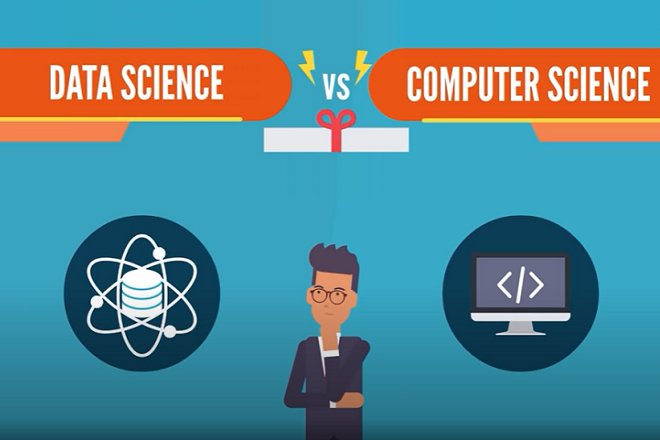People will hear about two disciplines: data science and computer science. Too often, these two disciplines are interchanged with each other. But are they really the same discipline? Or are data science and computer science different from each other? Perhaps they have some things in common, and yet differ from each other.
Curious about difference between data science vs computer science? You’ve come to the right place!
In this article, we will thoroughly explore the two disciplines by focusing on their definitions, the various areas that they explore, and how they’ve came to be. The ultimate goal of this guide is to get a full understanding of the two.
Without further ado, we will get right into both data science and computer science.
At First Glance
At a glance, the two disciplines may look and sound the same. However, upon further inspection, the two have varying focuses. Here, they are described as follows:
- Data science is the disciple that looks into tons of information submitted by human input every day. WHEREAS,
- Computer science mainly focuses on designing computers, while navigating through the digital architecture, and understanding the theory behind the digital landscape.
Needless to say, so far, data science acts as the basic tool for computer scientists to comprehend algorithms and programming. So, possibly, the two fields aren’t as different as one might believe.
Diving Deeper
Now, what we’ve discussed in the previous section was only the gist of the two disciplines. Now, lets dive deeper, where we’ll explore the following:
- Their definitions
- The histories behind them, AND
- Their lists of principles
As we look into these two disciplines further, you’ll get a better understanding of how each work without needing to decide which is the “better one,” since you’ll most likely need to know both.
Data Science
In essence, data science has a main focus on doing the following with data: collecting, organizing, and analyzing. By doing these things, the discipline lets you view data as a unique concoction of math, computer science, and statistics.
Practitioners known as data scientists use various techniques on computers, along with statistical analysis, to transform a lot of information into insights that people can use. First, data scientists collect the data from data sources by cleaning salvageable data, and erasing the bad data. Whatever is viable to use, data scientists will collect and save. Next, the data will be organized using categorization, alphabetizing, graphing, charting, etc. Afterwards, the data is analyzed, and then translated into workable solutions, depending on the industry.
Data science isn’t just for business intelligence, but also for other various fields, such as:
- Athletics
- Coding (HTML5, JavaScript, Python, etc.)
- Economics
- Education
- Forensics
- Healthcare
- Operations research
Essentially, data science holds the key to information that can be incorporated in virtually any field.
So, how did data science come about?
History
Believe it or not, data science seemed to have gotten its official start when mathematician John W. Tukey in 1962 suggested that the discipline would evolve as a modern-day electronic computing on data analysis – a type of science that would be further discovered. He later went on to publish Exploratory Data Analysis in 1977, of which he explains that data should be used to create hypotheses and test them, and that Exploratory Data Analysis and Confirmatory Data Analysis needed to work together to make these testing possible.
This experimentation wouldn’t be fully realized until 1997, until the launch of the journal Data Mining and Knowledge Discovery. This journal sung the praises of something called “data mining,” which was a practice of collecting data from very large databases.
As the 2000s rolled in, data science grew more in popularity, with people looking into data science. As their curiosities grew, so did the need for data science to become a discipline – one that can be taught in schools. According to the University of Wisconsin, 2005 was when the National Science Board called for data science to be an official discipline – a career path for those looking to delve into the world of data.
However, the call for the field to be an educational path to careers wasn’t fully realized until the 2010s, when there was a demand for more technological advancements. It was through the release of the Apple iPad and the iPhone in 2010 that people started to realize that data mining was a significant part of developing such wonderous and revolutionary technologies.
Today, data science is treated as a discipline, and is offered in various college and university programs.
Principles
Now, since it’s an evolving discipline, data science has principles that essentially allows the data to speak for itself. Therefore, scientists will find themselves collecting, organizing, and analyzing data on their end.
Just keep in mind: Since data is always evolving, so will its principles. In other words, the principles of data science may be one thing today, but something completely different tomorrow.
With that said, here are some of the elements of data science (again, many of these are subject to change):
- Communication
- Concrete objectives
- Data mining
- Data modeling
- Decision-making
- Experimentation
- Machine learning
- Measurable metrics
- Statistical learning
- Uncertainty
As you can see, these principles place the scientist in an analytical position, rather than actually testing and playing with data.
That’s where computer science comes in!
Computer Science
As for computer science, it’s far more complex than data science, to say the least. However, there’s a reason for that.
Computer science is more than just analyzing data, but also focuses on the idea of “computing.” Though, rather than just being the foundation for everything computing, this discipline also involves the following:
- Algorithms
- Artificial intelligence (AI)
- Computer hardware
- Computer software
- Cyber security
- Data infrastructure
- Data modeling
- Information technology
- Networks, etc.
Yes, all of this can be a mouthful, when it comes to computer science; however, this is the reality for various industries. Such industries include:
- Business
- Communications
- Entertainment
- Manufacturing
- Medicine
- Science
- Technology, and so on.
Essentially, computer scientists will be experimenting with data, rather than watch the data. In fact, this type of scientists will be responsible for developing technologies, solving problems in the digital realm, and designing new software and applications. Needless to say, their studies on computers and algorithms would prove most beneficial, especially when working with data.
So, how did computer science get its start?
History
First and foremost, humans have been like “computers” for many years. In other words, we learn from the things that we do, the things that we say, and the things that we experience. With that said, computer science seems to be a lot older than modern data science, so to speak.
Now, in terms of computers themselves, computer science with actual computers didn’t come into fruition until the early 1960s, when it was treated as only an independent discipline. Keep in mind that the electronic digital computer for consumer use wasn’t invented until two decades later. In the meantime, computer science resided within the following fields:
- Electrical engineering
- Management information systems
- Mathematics, AND
- Physics
Management information systems is one significant field when talking about computer science, because it allowed companies to have computers that stored tons of data. Again, computers weren’t able for consumers just yet, but the corporate computers were able to function with management information systems. Essentially, corporate computers were just there to do… well, corporate things such as:
- Accounting
- Managing inventory
- Payroll
- Production
- Receiving
- Shipping, etc.
However, it wasn’t until the emergence of the Internet in the 1980s that computer science started to spread into consumer society. Once computers grew more personal, moving into the homes of consumers, computer science had spread itself into various fields, including:
- Algorithms
- Architecture
- Communication
- Computational science
- Graphics and visual computing
- Human-computer interaction
- Information management
- Operating systems
- Platform-based development
- Programming languages
- Security
- Software engineering, and so on.
Years later, talk of artificial intelligence (AI) would take center stage in computer science. This had many scientists speculate if whether or not computers will grow more intelligent as technology evolves. Whether or not computers will be just as intelligent as humans – or smarter – is still a mystery.
Principles
Now, like data science, computer science has its own principles as well. However, computer science has principles that involves a lot of testing and execution. Unlike data science, computer science allows scientists to put the data to work, rather than just have the data speak for itself.
With that in mind, computer science consists of the following principles:
- Abstraction
- Creativity
- Complexity
- Consistency
- Efficiency
- Evolution
- Impact
- Modeling
- Order in space
- Security
- Tradeoffs
Conclusion
Ultimately, data science and computer science can be used in conjunction with each other. While the two are similar in more ways than one, they’re actually different, in terms of how they’re implemented. In other words, think of computer science as your development platform – or a builder – for technology, with data science as your tool box.
As a recap:
- Data science involves researching, categorizing, and analyzing data. WHEREAS,
- Computer science involves programming, networking, automating, and developing what was gathered through data science.
We hope that this guide has helped you to understand the difference between data science vs computer science, and that you can now embrace them with confidence!
Christina Lee is a writer and editor at Best essay writing services. As a social media strategist, she helps companies improve their social media presence and their online marketing strategies. As a content writer, she writes articles about business management, coding, and computer science.




